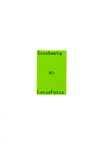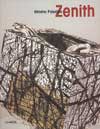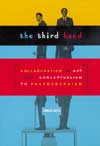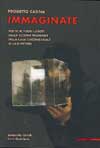|
|
|
Sonsbeek 9. LocusFocus
This catalogue documents the ninth edition of the art event, held in Arnhem. It is the first published volume, after which a second, the Appendix, will follow. The aim of this first component is to gather all the theories and ideas dealing with contemporary art that is destined for public spaces, as well as to introduce the complete biographies of the invited artists. The second part will instead be dedicated to the critical and photographic documentation of the site-specific works that were realized for the event. Critical texts are by Jan Hoet, curator of the show, and Dieter Roelstraete. The graphic choice graphical for the page numbering is particularly striking: a big fluorescent green rectangle in the center of every page, including the front and back covers.
Sonsbeek 9. LocusFocus, Stichting Sonsbeek 2001 (Klingelbeekseweg 19, Arnhem, www.sonsbeek2001.nl), 2001, 388 pages, 17 x 24.5 cm.
|

|
Mimmo Paladino. Zenith
This catalogue was realized to coincide with Mimmo Paladino’s solo show, curated by Alberto Fiz and held at the Santuario di Oropa, in Biella. The volume presents his artistic output of the last few years, such as the two painted cycles “Zenith” (1999) and “Laboratorio” (2000), “a kind of Leonardo-like codex” as the curator writes in the introductory text. “The Dormienti” and “Architetture” sculptural series’ are also well documented. Critical texts written by Alberto Fiz and James Puthnam appear in both Italian and English.
Mimmo Paladino. Zenith, Edizioni Charta (via della Moscova 27, Milan, 2001, 101 pages, 21 x 26.5 cm.
|

|
The Third Hand
This book is a fascinating critical analysis exploring artist groups, a phenomenon that has become increasingly common since the ’60s. The “third hand” of the title alludes to this concept of collaboration, for which the author, Charles Green, has created three distinct categories. The first denotes the type of formal exchange instituted by Joseph Kosuth, Ian Burn, Mel Ramsden, and other members of Art & Public at the end of the ’60s. The second form of collaboration is of a very close kind, in which the intent to make art together coincides with a strong bond in the artists’ private lives, such as marriage or co-habitation—for an example, one need look no further than that of the Boyle Family with Anne and Patrick Poirier, Helen Mayer Harrison and Newton Harrison. Green’s work concludes with those famous couples that have developed the notion of the “third hand” to the full. Examples include Christo and Jeanne-Claude, Gilbert & George, and Marina Abramovic with Ulay.
Charles Green, The Third Hand. Collaboration in Art from Conceptualism to Postmodernism, University of Minnesota Press (111 Third Avenue South, Suite 290, Minneapolis, www.upress.umn.edu), 2001, 248 pages, 18 x 25 cm.
|

|
The Gift
The Gift is an extensive catalogue published to coordinate with the show of the same name, which was held at the Sienese contemporary art center, the Palazzo delle Papesse, and which will travel to the Centro Culturale Candiani in Mestre. The conceptual thread that connects the works on show is the idea of the gift, the relational exchange in giving and receiving, and how it is reflected in contemporary artistic practice. There are numerous and diverse texts written by both Italian and British critics: on the philosophy of the gift, by Jean Baudrillard, Riccardo Caldura, Jacques Derrida, Raul Kirchmayr, Jean-Luc Marion, Piero Montani, Jean-Luc Nancy, and Alfredo Salsano; on the sociological aspect of giving, by Alain Caillé, Franco La Cecla, and Antonio Marazzi; and on the depiction of giving in art and literature by Chiara Bertola, Giorgina Bertolino, Nicolas Bourriaud, Jacqueline Burckhardt, Dan Cameron, Nicola Gandini, Henry Meyric Hughes, Corneli Lauf, Martino Marazzi, and Marco Senaldi.
The Gift. Generous Offerings Threatening Hospitality, Charta Press (Via della Moscova 27, Milan), 2001, 518 pages, 17 x 24 cm.
|

|
Progetto Casina. Immaginate. Poetiche fuori luogo dalla sezione femminile della Casa Circondariale di San Vittore
This volume presents the material gathered during the events and workshops that were part of the special project, Progetto Casina, involving inmates from the female section of San Vittore prison in Milan. The central part of the catalogue, entitled Immaginate (Imagine), presents a series of poems that grew out of the open forum, held in April 1999, between Luca Quartana, Antonella Ortelli and the inmates. The poetry is also accompanied by prose texts and drawings. The concept is clear: to provide, within the institutional framework, an artistic experience for people free of any previous kind of aesthetic research and devoid of close human relationships, such as those detained in prison. With this is mind, Francesca's text is particularly moving when it speaks of her son making a present out of his “little hand.” “It was something that we had always done together: to draw the outline of his hand inside the outline of mine. It’s something always do when I feel the absence of human contact.”
Progetto Casina. Immaginate. Poetiche fuori luogo dalla sezione femminile della Casa Circondariale di San Vittore, Edizioni Gabriele Mazzotta (Foro Buonaparte 52, Milan), 2001, 139 pages, 16 x 22 cm.
|

|
|
|
|